User:JMvanDijk/Sandbox 9/Box 4
| House of Habsburg | |
|---|---|
| Imperial house | |
 Coat of arms of Habsburg depicted (1890) by Hugo Gerard Ströhl | |
| Country | |
| Etymology | Habsburg Castle |
| Founded | 11th century |
| Founder | Radbot, Count of Habsburg |
| Final ruler | Empress Maria Theresa |
| Titles | List
|
| Dissolution | November 29, 1780 |
| Cadet branches | |
The House of Habsburg (/ˈhæpsbɜːrɡ/; German pronunciation: [ˈhaːpsbʊʁk]), also called House of Austria,[1] was one of the most influential and outstanding royal houses of Europe. The throne of the Holy Roman Empire was continuously occupied by the Habsburgs between 1438 and 1740. The house also produced emperors and kings of the Kingdom of Bohemia, Kingdom of England (Jure uxoris King), Kingdom of Germany, Kingdom of Hungary, Kingdom of Croatia, Second Mexican Empire, Kingdom of Ireland (Jure uxoris King), Kingdom of Portugal, and Spain, as well as rulers of several Dutch and Italian principalities.[dubious – discuss] From the 16th century, following the reign of Charles V, the dynasty was split between its Austrian and Spanish branches. Although they ruled distinct territories, they nevertheless maintained close relations and frequently intermarried.
The House takes its name from Habsburg Castle, a fortress built in the 1020s in present-day Switzerland, in the canton of Aargau, by Count Radbot of Klettgau, who chose to name his fortress Habsburg. His grandson Otto II was the first to take the fortress name as his own, adding "Count of Habsburg" to his title. The House of Habsburg gathered dynastic momentum through the 11th, 12th, and 13th centuries.
By 1276, Count Radbot's seventh generation descendant Rudolph of Habsburg had moved the family's power base from Habsburg Castle to the Duchy of Austria. Rudolph had become King of Germany in 1273, and the dynasty of the House of Habsburg was truly entrenched in 1276 when Rudolph became ruler of Austria, which the Habsburgs ruled until 1918.
A series of dynastic marriages[2] enabled the family to vastly expand its domains to include Burgundy, Spain and its colonial empire, Bohemia, Hungary, and other territories. In the 16th century, the family separated into the senior Habsburg Spain and the junior Habsburg Monarchy branches, who settled their mutual claims in the Oñate treaty.
The House of Habsburg became extinct in the 18th century. The senior Spanish branch ended upon the death of Charles II of Spain in 1700 and was replaced by the House of Bourbon. The remaining Austrian branch became extinct in the male line in 1740 with the death of Holy Roman Emperor Charles VI, and completely in 1780 with the death of his eldest daughter Maria Theresa of Austria. It was succeeded by the Vaudemont branch of the House of Lorraine. The new successor house styled itself formally as the House of Habsburg-Lorraine (German: Habsburg-Lothringen), and because it was often confusingly still referred to as the House of Habsburg, historians use the unofficial appellation of the Habsburg Monarchy for the countries and provinces that were ruled by the junior Austrian branch of the House of Habsburg between 1521 and 1780 and then by the successor branch of Habsburg-Lorraine until 1918.
Principal roles
[edit]Their principal roles (including the roles of their cadet branches) were as follows:
- Holy Roman Emperors (intermittently from 1273 until 1806), kings of Germany,[3] and kings of the Romans[4])
- Rulers of Austria (as dukes from 1278 until 1453; as archdukes from 1453 until 1806/1918; as emperors from 1804 until 1918)
- Kings of Bohemia (1306–1307, 1437–1439, 1453–1457, 1526–1918)
- Kings of Hungary and Croatia (1526–1918)
- Kings of Spain (1516–1700)
- Kings of Portugal (1581–1640)
- Kings of Galicia and Lodomeria (1772–1918)
- Grand princes of Transylvania (1690–1867)
Numerous other titles were attached to the crowns listed above.
History
[edit]| History of Austria |
|---|
 |
|
|
Counts of Habsburg
[edit]
The progenitor of the House of Habsburg may have been Guntram the Rich, a count in the Breisgau who lived in the 10th century, and forewith farther back as the early medieval Adalrich, Duke of Alsace, father of the Etichonids from which Habsburg derives. His grandson Radbot, Count of Habsburg founded the Habsburg Castle, after which the Habsburgs are named. The origins of the castle's name, located in what is now the Swiss canton of Aargau, are uncertain. There is disagreement on whether the name is derived from the High German Habichtsburg (hawk castle), or from the Middle High German word hab/hap meaning ford, as there is a river with a ford nearby. The first documented use of the name by the dynasty itself has been traced to the year 1108.[5][6][7] The Habsburg Castle was the family seat in the 11th, 12th and 13th centuries.
The Habsburgs expanded their influence through arranged marriages and by gaining political privileges, especially countship rights in Zürichgau, Aargau and Thurgau. In the 13th century, the house aimed its marriage policy at families in Upper Alsace and Swabia. They were also able to gain high positions in the church hierarchy for their members. Territorially, they often profited from the extinction of other noble families such as the House of Kyburg.[8]
Kings of the Romans
[edit]By the second half of the 13th century, count Rudolph IV (1218–1291) had become one of the most influential territorial lords in the area between the Vosges Mountains and Lake Constance. Due to these impressive preconditions, on 1 October, 1273, Rudolph was chosen as the King of the Romans and received the name Rudolph I of Germany.[8]
In 1282, the Habsburgs gained the rulership of the Duchy of Austria, which they then held for over 600 years, until 1918. Through the forged privilegium maius document (1358/59), a special bond was created between the house and Austria. The document, forged at the behest of Rudolf IV, Duke of Austria (1339–1365), also attempted to introduce rules to preserve the unity of the family's Austrian lands. In the long term, this indeed succeeded, but Rudolph's descendants ignored the rule, leading to the separation of the Albertian and Leopoldian family lines in 1379.[8]
By marrying Elisabeth of Luxembourg, the daughter of Holy Roman Emperor Sigismund in 1437, Duke Albert V (1397–1439) became the ruler of Bohemia and Hungary, expanding the family's political horizons. The next year, Albert V was crowned as the King of the Romans as Albert II. After his early death in war with the Turks in 1439, and after the death of his son Ladislaus Postumus in 1457, the Habsburgs lost Bohemia and Hungary again. National kingdoms were established in these areas, and the Habsburgs were not able to restore their influence there for decades.
Holy Roman emperors
[edit]
In 1440, Frederick III was chosen by the electoral college to succeed Albert II as the king. Several Habsburg kings had attempted to gain the imperial throne over the years, but success finally arrived on 19 March, 1452, when Pope Nicholas V crowned Frederick III as the Holy Roman Emperor in a grand ceremony held in Rome. In Frederick III, the Pope found an important political ally with whose help he was able to counter the conciliar movement.[8]
While in Rome, Frederick III married Eleanor of Portugal, enabling him to build a network of connections with dynasties in the west and southeast of Europe. Frederick was rather distant to his family; Eleanor, by contrast, had a great influence on the raising and education of Frederick's children, and therefore played an important role in the family's rise to prominence. After Frederick III's coronation, the Habsburgs were able to hold the imperial throne almost continuously for centuries, until 1806.[8]
As emperor, Frederick III took a leading role inside the family and positioned himself as the judge over the family's internal conflicts, often making use of the privilegium maius. He was able to restore the unity of the house's Austrian lands, as the Albertinian line was now extinct. Territorial integrity was also strengthened by the extinction of the Tyrolean branch of the Leopoldian line in 1490/1496. Frederick's aim was to make Austria a united country, stretching from the Rhine to the Mur and Leitha.[8]
On the external front, one of Frederick's main achievements was the Siege of Neuss (1474–75), in which he forced Charles the Bold of Burgundy to give his daughter Mary of Burgundy as wife to Frederick's son Maximilian.[8] The wedding took place on the evening of 16 August 1477 and ultimately resulted in the Habsburgs acquiring control of the Low Countries. After Mary's early death in 1482, Maximilian attempted to secure the Burgundian heritance to one of his and Mary's children Philip the Handsome. Charles VIII of France contested this, using both military and dynastic means, but the Burgundian succession was finally ruled in favour of Philip in the Treaty of Senlis in 1493.[9]
After the death of his father in 1493, Maximilian was proclaimed the new King of the Romans, receiving the name Maximilian I. Maximilian was initially unable to travel to Rome to receive the Imperial title from the Pope, due to opposition from Venice and from the French who were occupying Milan, as well a refusal from the Pope due to enemy forces being present on his territory. In 1508, Maximilian proclaimed himself as the "chosen Emperor," and this was also recognized by the Pope due to changes in political alliances. This had a historical consequence in that, in the future, the Roman King would also automatically become Emperor, without needing the Pope's consent. In 1530, Emperor Charles V became the last person to be crowned as the Emperor by the Pope.[9]

Maximilian's rule (1493–1519) was a time of great expansion for the Habsburgs. In 1497, Maximilian's son Philip the Handsome (also known as Phillip the Fair) married Joanna of Castile, also known as Joan the Mad, heiress of Castile, Aragon, and most of Spain. Phillip and Joan had six children, the eldest of whom became Charles V and inherited the kingdoms of Castile and Aragon (including their colonies in the New World), Southern Italy, Austria, and the Low Countries.[10]
The foundations for the later empire of Austria-Hungary were laid in 1515 by the means of a double wedding between Louis, only son of Vladislaus II, King of Bohemia and Hungary, and Maximilian's granddaughter Mary; and between her brother Archduke Ferdinand and Vladislaus' daughter Anna. The wedding was celebrated in grand style on 22 July 1515, and has been described by some historians as the First Congress of Vienna due to its significant implications for Europe's political landscape. All the children were still minors, so the wedding was formally completed in 1521. Vladislaus died on 13 March 1516, and Maximilian died on 12 January 1519, but his designs were ultimately successful: on Louis's death in 1526, Maximilian's grandson Ferdinand I, Holy Roman Emperor, became the King of Bohemia.
The Habsburg dynasty achieved the position of a true world power by the time of Charles V, for the first and only time in their history—the "World Emperor" ruling an "empire on which the sun never sets".
The Habsburgs' policies against Protestantism led to an eradication of the former in throughout vast areas under their control.
Division of the house: Spanish and Austrian Habsburgs
[edit]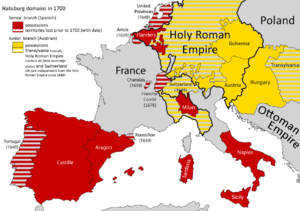
After the assignment, on 21 April 1521, of the Austrian lands to Ferdinand I by his brother Emperor Charles V (also King Charles I of Spain) (1516–1556), the dynasty split into the junior branch of the Austrian Habsburgs and the senior branch of the Spanish Habsburgs. The Austrian Habsburgs held the title of Holy Roman Emperor after Charles' death in 1558, as well as the Habsburg Hereditary Lands and the Kingdoms of Bohemia and Hungary.
The senior Spanish branch ruled over Spain, its Italian possessions and its colonial empire, the Netherlands, and, for a time (1580–1640), Portugal. Hungary was partly under Habsburg rule from 1526. For 150 years most of the country was occupied by the Ottoman Turks but these territories were re-conquered in 1683–1699.
In the secret Oñate treaty, the Spanish and Austrian Habsburgs settled their mutual claims. The Spanish Habsburgs died out in 1700 (prompting the War of the Spanish Succession), as did the last male of the Austrian Habsburg line in 1740 (prompting the War of the Austrian Succession), and finally the last female of the Habsburg male line in 1780.
Extinction of the Spanish Habsburgs
[edit]The Habsburgs sought to consolidate their power by the frequent use of consanguineous marriages. This resulted in a cumulatively deleterious effect on their gene pool. Marriages between first cousins, or between uncle and niece, were commonplace in the family. A study of 3,000 family members over 16 generations by the University of Santiago de Compostela suggests that inbreeding directly led to their extinction. The gene pool eventually became so small that the last of the Spanish line Charles II, who was severely disabled from birth, perhaps by genetic disorders, possessed a genome comparable to that of a child born to a brother and sister, as did his father, probably because of "remote inbreeding".[11][12]
Extinction of the Austrian Habsburgs
[edit]The Austrian branch became extinct in the male line in 1740 with the death of Charles VI and in the female line in 1780 with the death of his daughter Maria Theresa; it was succeeded by the Vaudemont branch of the House of Lorraine in the person of her son Joseph II. The new successor house styled itself formally as House of Habsburg-Lorraine (German: Habsburg-Lothringen), although it was often referred to as simply the House of Habsburg. The heiress of the last Austrian Habsburgs Maria Theresa had married Francis Stephan, Duke of Lorraine[13] (both of them were great-grandchildren of Habsburg Emperor Ferdinand III, but from different empresses). Their descendants carried on the Habsburg tradition from Vienna under the dynastic name Habsburg-Lorraine, although technically a new ruling house came into existence in the Austrian territories, the House of Lorraine (see Dukes of Lorraine family tree). It is thought that extensive intra-family marriages within both lines contributed to their extinctions.
Habsburg-Lorraine
[edit]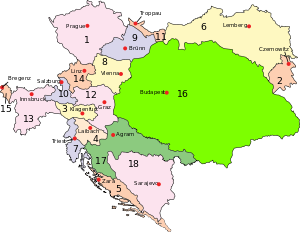 Kingdoms and countries of Austria-Hungary: Cisleithania (Empire of Austria[14]): 1. Bohemia, 2. Bukovina, 3. Carinthia, 4. Carniola, 5. Dalmatia, 6. Galicia, 7. Küstenland, 8. Lower Austria, 9. Moravia, 10. Salzburg, 11. Silesia, 12. Styria, 13. Tirol, 14. Upper Austria, 15. Vorarlberg; Transleithania (Kingdom of Hungary[14]): 16. Hungary proper 17. Croatia-Slavonia; 18. Bosnia and Herzegovina (Austro-Hungarian condominium) |
On 6 August 1806 the Holy Roman Empire was dissolved under the French Emperor Napoleon I's reorganization of Germany. However, in anticipation of the loss of his title of Holy Roman Emperor, Francis II declared himself hereditary Emperor of Austria (as Francis I) on 11 August 1804, three months after Napoleon had declared himself Emperor of the French on 18 May 1804.
Emperor Francis I of Austria used the official full list of titles: "We, Francis the First, by the grace of God Emperor of Austria; King of Jerusalem, Hungary, Bohemia, Dalmatia, Croatia, Slavonia, Galicia and Lodomeria; Archduke of Austria; Duke of Lorraine, Salzburg, Würzburg, Franconia, Styria, Carinthia, and Carniola; Grand Duke of Cracow; Grand Prince of Transylvania; Margrave of Moravia; Duke of Sandomir, Masovia, Lublin, Upper and Lower Silesia, Auschwitz and Zator, Teschen, and Friule; Prince of Berchtesgaden and Mergentheim; Princely Count of Habsburg, Gorizia, and Gradisca and of the Tyrol; and Margrave of Upper and Lower Lusatia and Istria".
The Austro-Hungarian Compromise of 1867 created a real union, whereby the Kingdom of Hungary was granted co-equality with the Empire of Austria, that henceforth didn't include the Kingdom of Hungary as a crownland anymore. The Austrian and the Hungarian lands became independent entities enjoying equal status[15] Under this arrangement, the Hungarians referred to their ruler as king and never emperor (see k. u. k.). This prevailed until the Habsburgs' deposition from both Austria and Hungary in 1918 following defeat in World War I.

On 11 November 1918, with his empire collapsing around him, the last Habsburg ruler, Charles I (who also reigned as Charles IV of Hungary) issued a proclamation recognizing Austria's right to determine the future of the state and renouncing any role in state affairs. Two days later, he issued a separate proclamation for Hungary. Even though he did not officially abdicate, this is considered the end of the Habsburg dynasty. In 1919, the new republican Austrian government subsequently passed a law banishing the Habsburgs from Austrian territory until they renounced all intentions of regaining the throne and accepted the status of private citizens. Charles made several attempts to regain the throne of Hungary, and in 1921 the Hungarian government passed a law which revoked Charles' rights and dethroned the Habsburgs.
The Habsburgs did not formally abandon all hope of returning to power until Otto von Habsburg, the eldest son of Charles I, renounced all claims to the throne.
The dynasty's motto, "Leave the waging of wars to others! But you, happy Austria, marry; for the realms which Mars awards to others, Venus transfers to you.",[16] indicates the knack of the Habsburgs to have members intermarry into other royal houses in order to build alliances and inherit territory. Empress Maria Theresa is recognized quite notably for it and is sometimes referred to as the "Great-Grandmother of Europe".[citation needed]
Family tree
[edit]Ancestors of the Habsburgs
[edit]Fragmentary references (see below) cite the Habsburgs as descendants of the early Germanic Etichonider, probably of Frankish, Burgundian or Visigothic origin, who ruled the Duchy of Alsace in the Early Middle Ages (7th–10th centuries). The dynasty is named for Eticho (also known as Aldarich) who ruled from 662 to 690.
| Eticho I (635-690) r.662-690 Count of Alsace | |||||||||||||||||||||||||||||||||
| Eticho II (700-723) r.722-723 Count of Nordgau | |||||||||||||||||||||||||||||||||
| Alberic I d.747 r.723-747 Count of Nordgau | |||||||||||||||||||||||||||||||||
| Eberhard II d.777 r.765-777 Count of Nordgau | |||||||||||||||||||||||||||||||||
| Eberhard III of Dillingen d.874 r.817-864 Count of Nordgau | |||||||||||||||||||||||||||||||||
| ? | |||||||||||||||||||||||||||||||||
| Hugo III d.940 r.910-940 Count of Nordgau | |||||||||||||||||||||||||||||||||
| Guntram the Rich[17] Count in Breisgau c.920-973 member of Etichonider family | Eberhard IV d.972/3 | ||||||||||||||||||||||||||||||||
Early Habsburgs
[edit]Family tree of the ancestors of the Habsburg family, largely before becoming Holy Roman Emperors and (Arch)Dukes of Austria. This family tree only includes male scions of the House of Habsburg from 920 to 1308.[18] Otto II was probably the first to take the Habsburg Castle name as his own, adding "von Habsburg" to his title and creating the House of Habsburg.[19]. See below for more references.
| Guntram the Rich[20] Count in Breisgau c.920-973 member of Etichonider family | |||||||||||||||||||||||||||||||||
| Lanzelin of Klettgau and Altenburg | |||||||||||||||||||||||||||||||||
| Werner I Bishop of Strasbourg c.978/980-1028 | Radbot of Klettgau built Habsburg Castle Count of Habsburg c.985-1045 | ||||||||||||||||||||||||||||||||
| Werner I the Pious[21] Count of Habsburg c.1025/1030-1096 | |||||||||||||||||||||||||||||||||
| Otto II Count of Habsburg 1096-1111 | |||||||||||||||||||||||||||||||||
| Werner II Count of Habsburg 1111-1167 | |||||||||||||||||||||||||||||||||
| Otto III Bishop of Constance 1166-1174 | Albert III Count of Habsburg 1167-1199 | ||||||||||||||||||||||||||||||||
| Rudolf II Count of Habsburg 1199-1232 | |||||||||||||||||||||||||||||||||
| Albert IV Count of Habsburg 1232-1239 | Rudolf III Count of Habsburg 1232 Count of Laufenburg 1232-1249 | ||||||||||||||||||||||||||||||||
| Rudolf IV (I) Count of Habsburg 1240-1291 King of Germany 1273-1291 Duke of Austria and Styria 1278-1282 Duke of Carinthia 1276-1286  | Eberhard I Count of Kiburg 1249-1284 | Gottfried I Count of Laufenburg 1249-1271 | |||||||||||||||||||||||||||||||
| Albert I Duke of Austria, Styria and Carniola 1282-1308 Holy Roman Emperor 1298-1308  | Rudolf II Duke of Swabia 1282-1290 Duke of Austria 1282-1283 | Kiburg Line 1284-1414 | Laufenburg Line 1271-1408 | ||||||||||||||||||||||||||||||
| John the Parricide (murdered his uncle Albert I) | |||||||||||||||||||||||||||||||||
| House of Austria see below | |||||||||||||||||||||||||||||||||
Middle Habsburgs
[edit]| Male scions of the direct House of Habsburg who survived to adulthood[22] | |||||||||||||||||||||||||||||||||||||||||||||||||||||||||||||||||||||||||||||||||||||||||||||||||||||||||||||||||||||||||||||||||||||||||||||||||||||||||||||||||||||||||||||||||||||||||||||||||||||||||||||||||||||||||||||||||||||||||||||||||||||||||||||||||||||||||||||||||||||||||||||||||||||||||||||||||||||||||||||||||||||||||||||||||||||||||||||||||||||||||||||||||||||||||||||||||||||||||||||||||||||||||||||||||||||||||||||||||||||||||||||||||||||||||||||||||||||||||||||||||||||||||||||||||||||||||||||||||||||||||||||||||||||||||||||||||||||||||||||||||||||||||||||||||||||||||||||||||||||||||||||||||||||||||||||||||||||||||||||||||||||||||||||||||||||||||||||||||||||||||||||||||||||||||||||||||||||||||||||||||||||||||||||||||||||||||||||||||||||||||||||||||||||||||||||||||||||||||||||||||||||||||||||||||||||||||||||||||||||||||||||||||||||||||||||||||||||||||||||||||||||||||||||||||||||||||||||||||||||||||||||||||||||||||||||||||||||||||||||||||||||||||||||||||||||||||||||||||||||||
|---|---|---|---|---|---|---|---|---|---|---|---|---|---|---|---|---|---|---|---|---|---|---|---|---|---|---|---|---|---|---|---|---|---|---|---|---|---|---|---|---|---|---|---|---|---|---|---|---|---|---|---|---|---|---|---|---|---|---|---|---|---|---|---|---|---|---|---|---|---|---|---|---|---|---|---|---|---|---|---|---|---|---|---|---|---|---|---|---|---|---|---|---|---|---|---|---|---|---|---|---|---|---|---|---|---|---|---|---|---|---|---|---|---|---|---|---|---|---|---|---|---|---|---|---|---|---|---|---|---|---|---|---|---|---|---|---|---|---|---|---|---|---|---|---|---|---|---|---|---|---|---|---|---|---|---|---|---|---|---|---|---|---|---|---|---|---|---|---|---|---|---|---|---|---|---|---|---|---|---|---|---|---|---|---|---|---|---|---|---|---|---|---|---|---|---|---|---|---|---|---|---|---|---|---|---|---|---|---|---|---|---|---|---|---|---|---|---|---|---|---|---|---|---|---|---|---|---|---|---|---|---|---|---|---|---|---|---|---|---|---|---|---|---|---|---|---|---|---|---|---|---|---|---|---|---|---|---|---|---|---|---|---|---|---|---|---|---|---|---|---|---|---|---|---|---|---|---|---|---|---|---|---|---|---|---|---|---|---|---|---|---|---|---|---|---|---|---|---|---|---|---|---|---|---|---|---|---|---|---|---|---|---|---|---|---|---|---|---|---|---|---|---|---|---|---|---|---|---|---|---|---|---|---|---|---|---|---|---|---|---|---|---|---|---|---|---|---|---|---|---|---|---|---|---|---|---|---|---|---|---|---|---|---|---|---|---|---|---|---|---|---|---|---|---|---|---|---|---|---|---|---|---|---|---|---|---|---|---|---|---|---|---|---|---|---|---|---|---|---|---|---|---|---|---|---|---|---|---|---|---|---|---|---|---|---|---|---|---|---|---|---|---|---|---|---|---|---|---|---|---|---|---|---|---|---|---|---|---|---|---|---|---|---|---|---|---|---|---|---|---|---|---|---|---|---|---|---|---|---|---|---|---|---|---|---|---|---|---|---|---|---|---|---|---|---|---|---|---|---|---|---|---|---|---|---|---|---|---|---|---|---|---|---|---|---|---|---|---|---|---|---|---|---|---|---|---|---|---|---|---|---|---|---|---|---|---|---|---|---|---|---|---|---|---|---|---|---|---|---|---|---|---|---|---|---|---|---|---|---|---|---|---|---|---|---|---|---|---|---|---|---|---|---|---|---|---|---|---|---|---|---|---|---|---|---|---|---|---|---|---|---|---|---|---|---|---|---|---|---|---|---|---|---|---|---|---|---|---|---|---|---|---|---|---|---|---|---|---|---|---|---|---|---|---|---|---|---|---|---|---|---|---|---|---|---|---|---|---|---|---|---|---|---|---|---|---|---|---|---|---|---|---|---|---|---|---|---|---|---|---|---|---|---|---|---|---|---|---|---|---|---|---|---|---|---|---|---|---|---|---|---|---|---|---|---|---|---|---|---|---|---|---|---|---|---|---|---|---|---|---|---|---|---|---|---|---|---|---|---|---|---|---|---|---|---|---|---|---|---|---|---|---|---|---|---|---|---|---|---|---|---|---|---|---|---|---|---|---|---|---|---|---|---|---|---|---|---|---|---|---|---|---|---|---|---|---|---|---|---|---|---|---|---|---|---|---|---|---|---|---|---|---|---|---|---|---|---|---|---|---|---|---|---|---|---|---|---|---|---|---|---|---|---|---|---|---|---|---|---|---|---|---|---|---|---|---|---|---|---|---|---|---|---|---|---|---|---|---|---|---|---|---|---|---|---|---|---|---|---|---|---|---|---|---|---|---|---|---|---|---|---|---|---|---|---|---|---|---|---|---|---|---|---|---|---|---|---|---|---|---|---|---|---|---|---|---|---|---|---|---|---|---|---|---|---|---|---|---|---|---|---|---|---|---|---|---|---|---|---|---|---|---|---|---|---|---|---|---|---|---|---|---|---|---|---|---|---|---|---|---|---|---|---|---|---|---|---|---|---|---|---|---|---|---|---|---|---|---|---|---|---|---|---|---|---|---|---|---|---|---|---|---|---|---|---|---|---|---|---|---|---|---|---|---|---|---|---|---|---|---|---|---|---|---|---|---|---|---|---|---|---|---|---|---|---|---|---|---|---|---|---|---|---|---|---|---|---|---|---|---|---|---|---|---|---|---|---|---|---|---|---|---|---|---|---|---|---|---|---|---|---|---|---|---|---|---|---|---|---|
| |||||||||||||||||||||||||||||||||||||||||||||||||||||||||||||||||||||||||||||||||||||||||||||||||||||||||||||||||||||||||||||||||||||||||||||||||||||||||||||||||||||||||||||||||||||||||||||||||||||||||||||||||||||||||||||||||||||||||||||||||||||||||||||||||||||||||||||||||||||||||||||||||||||||||||||||||||||||||||||||||||||||||||||||||||||||||||||||||||||||||||||||||||||||||||||||||||||||||||||||||||||||||||||||||||||||||||||||||||||||||||||||||||||||||||||||||||||||||||||||||||||||||||||||||||||||||||||||||||||||||||||||||||||||||||||||||||||||||||||||||||||||||||||||||||||||||||||||||||||||||||||||||||||||||||||||||||||||||||||||||||||||||||||||||||||||||||||||||||||||||||||||||||||||||||||||||||||||||||||||||||||||||||||||||||||||||||||||||||||||||||||||||||||||||||||||||||||||||||||||||||||||||||||||||||||||||||||||||||||||||||||||||||||||||||||||||||||||||||||||||||||||||||||||||||||||||||||||||||||||||||||||||||||||||||||||||||||||||||||||||||||||||||||||||||||||||||||||||||||||
Later Habsburgs
[edit]Similarly, this family tree only includes male scions of the House of Habsburg-Lorraine who survived to adulthood:
Monarchs of the House of Habsburg
[edit]The Habsburg Empire was never composed of a single unified and unitary state as Bourbon France, Hohenzollern Germany, or Great Britain was. It was made up of an accretion of territories that owed their historic loyalty to the head of the house of Habsburg as hereditary lord. The Habsburgs had mostly married the heiresses of these territories, most famously of Spain and the Netherlands. They used their coats of arms then as a statement of their right to rule all these territories. As there were many territories, so their arms were complex and reflected the waxing and waning position of the Habsburgs within European power politics. It was not until the 19th century (see below Arms of Dominion of the Austro-Hungarian Empire) that the arms began to take on their own life as symbols of a state which may have an existence outside of the Habsburg dynasty. A complete listing of the arms can be found at the Habsburg Armory.
Ancestors
[edit]- Guntram the Rich (ca. 930–985 / 990) Father of:[23] The chronology of the Muri Abbey, burial place of the early Habsburgs, written in the 11th century, states that Guntramnus Dives (Guntram the Rich), was the ancestor of the House of Habsburg. Many historians believe this indeed makes Guntram the progenitor of the House of Habsburg. However, this account was 200 years after the fact, and much about him and the origins of the Habsburgs is uncertain.[24] If true, as Guntram was a member of the member of Etichonider family, it would link the Habsburg lineage to this family.
- Lanzelin of Altenburg (died 991). Besides Radbot, below, he had sons named Rudolph I, Wernher, and Landolf.
Counts of Habsburg
[edit]
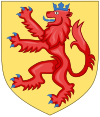
Before Rudolph rose to German king, the Habsburgs were Counts of Baden in what is today southwestern Germany and Switzerland.[23]
- Radbot of Klettgau, built the Habsburg Castle (c. 985 – 1035). Besides Werner I, he had two other sons: Otto I, who would become Count of Sundgau in the Alsace, and Albrecht I. Founded the Muri Abbey, which became the first burial place of members of the House of Habsburg. It is possible that Radbot founded the castle Habichtsburg, the residence of the House of Habsburg, but another possible founder is Werner I.[25]
- Werner I, Count of Habsburg (1025/1030–1096). Besides Otto II, there was another son, Albert II, who was reeve of Muri from 1111–1141 after the death of Otto II.
- Otto II of Habsburg; first to name himself as "of Habsburg"[26] (died 1111) Father of:
- Werner II of Habsburg (around 1135; died 1167) Father of:
- Albrecht III of Habsburg (the Rich), died 1199. Under him, the Habsburg territories expanded to cover most of what is today the German-speaking part of Switzerland. Father of:
- Rudolph II of Habsburg (b. c. 1160, died 1232) Father of:
- Albrecht IV of Habsburg, (died 1239 / 1240); father of Rudolph IV of Habsburg, who would later become king Rudolph I of Germany. Between Albrecht IV and his brother Rudolph III, the Habsburg properties were split, with Albrecht keeping the Aargau and the western parts, the eastern parts going to Rudolph III. Albrecht IV was also a mutual ancestor of Sophia Chotek and of her husband Archduke Franz Ferdinand of Austria
Dukes/Archdukes of Austria
[edit]

In the late Middle Ages, when the Habsburgs expanded their territories in the east, they usually ruled as dukes of the Duchy of Austria which covered only what is today Lower Austria (Niederösterreich) and the eastern part of Upper Austria (Oberösterreich). The Habsburg possessions also included the rest of what was then called Inner Austria (Innerösterreich), i.e. the Duchy of Styria, and then expanded west to include the Duchy of Carinthia and Carniola in 1335 and the Count of Tirol in 1363. Their original scattered possessions in the southern Alsace, south-western Germany and Vorarlberg were collectively known as Further Austria.
The senior Habsburg dynast generally ruled Lower Austria from Vienna as archduke ("paramount duke") of the Duchy of Austria. The Styrian lands had already been ruled in personal union by the Babenberg dukes of Austria since 1192 and were finally seized with the Austrian lands by the Habsburg king Rudolph I of Germany upon his victory in the 1278 Battle on the Marchfeld. In 1335 Rudolph's grandson Duke Albert II of Austria also received the Carinthian duchy with the adjacent March of Carniola at the hands of Emperor Louis the Bavarian as Imperial fiefs.
The Habsburg dukes gradually lost their homelands south of the Rhine and Lake Constance to the expanding Old Swiss Confederacy. Unless mentioned explicitly, the dukes of Austria also ruled over Further Austria until 1379, after that year, Further Austria was ruled by the Princely Count of Tyrol. Names in italics designate dukes who never actually ruled.
When Albert's son Duke Rudolf IV of Austria died in 1365, his younger brothers Albert III and Leopold III quarrelled about his heritage and in the Treaty of Neuberg of 1379 finally split the Habsburg territories: The Albertinian line would rule in the Archduchy of Austria proper (then sometimes referred to as "Lower Austria" (Niederösterreich), but comprising modern Lower Austria and most of Upper Austria), while the Leopoldian line ruled in the Styrian, Carinthian and Carniolan territories, subsumed under the denotation of "Inner Austria". At that time their share also comprised Tyrol and the original Habsburg possessions in Swabia, called Further Austria; sometimes both were collectively referred to as "Upper Austria" (Oberösterreich) in that context, also not to be confused with the modern state of that name.
After the death of Leopold's eldest son William in 1406, the Leopoldinian line was further split among his brothers into the Inner Austrian territory under Ernest the Iron and a Tyrolean/Further Austrian line under Frederick IV. In 1457 Ernest's son Duke Frederick V of Inner Austria also gained the Austrian archduchy after his Albertine cousin Ladislaus the Posthumous had died without issue. 1490 saw the reunification of all Habsburg lines, when Archduke Sigismund of Further Austria and Tyrol resigned in favour of Frederick's son Maximilian I. In 1512, the Habsburg territories were incorporated into the Imperial Austrian Circle.
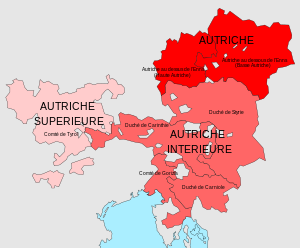
Archduke of Austria, was invented in the Privilegium Maius, a 14th-century forgery initiated by Duke Rudolf IV of Austria. Originally, it was meant to denote the "ruler" (thus "Arch-") of the duchy of Austria, usually from Vienna, in an effort to put the Habsburgs on a par with the Prince-electors, as Austria had been passed as hereditary prince-electors of the empire when the Golden Bull of 1356 assigned that title to the highest ranking Imperial princes. The Holy Roman Emperor Charles IV refused to recognise the title.
The archducal title was only officially recognized in 1453 by Emperor Frederick III.[27] Emperor Frederick III himself used just "Duke of Austria", never Archduke, until his death in 1493. The title was first granted to Frederick's younger brother, Albert VI of Austria (died 1463), who used it at least from 1458.
In 1477, Frederick III also granted the title archduke to his first cousin, Sigismund of Austria, ruler of Further Austria. Frederick's son and heir, the future Emperor Maximilian I, started to use the title, but apparently only after the death of his wife Mary of Burgundy (died 1482), as Archduke never appears in documents issued jointly by Maximilian and Mary as rulers in the Low Countries (where Maximilian is still titled "Duke of Austria"). The title appears first in documents issued under the joint rule of Maximilian and Philip (his under-age son) in the Low Countries.
Archduke was initially borne by those dynasts who ruled a Habsburg territory, i.e., only by males and their consorts, appanages being commonly distributed to cadets. But these "junior" archdukes did not thereby become independent hereditary rulers, since all territories remained vested in the Austrian crown. Occasionally a territory might be combined with a separate gubernatorial mandate ruled by an archducal cadet.
From the 16th century onward, archduke and its female form, archduchess, came to be used by all the members of the House of Habsburg (e.g., Queen Marie Antoinette of France was born Archduchess Maria Antonia of Austria.
- Rudolph II, son of Rudolph I, duke of Austria and Styria together with his brother 1282–1283, was dispossessed by his brother, who eventually would be murdered by one of Rudolph's sons.
- Albert I (Albrecht I), son of Rudolph I and brother of the above, duke from 1282–1308; was Holy Roman Emperor from 1298–1308. See also below.
- Rudolph III, oldest son of Albert I, designated duke of Austria and Styria 1298–1307
- Frederick the Handsome (Friedrich der Schöne), brother of Rudolph III. Duke of Austria and Styria (with his brother Leopold I) from 1308–1330; officially co-regent of emperor Louis IV since 1325, but never ruled.
- Leopold I, brother of the above, duke of Austria and Styria from 1308–1326.
- Albert II (Albrecht II), brother of the above, duke of Further Austria from 1326–1358, duke of Austria and Styria 1330–1358, duke of Carinthia after 1335.
- Otto the Jolly (der Fröhliche), brother of the above, duke of Austria and Styria 1330–1339 (together with his brother), duke of Carinthia after 1335.
- Rudolph IV the Founder (der Stifter), oldest son of Albert II. Duke of Austria and Styria 1358–1365, Duke of Tirol after 1363.
After the death of Rudolph IV, his brothers Albert III and Leopold III ruled the Habsburg possessions together from 1365 until 1379, when they split the territories in the Treaty of Neuberg, Albert keeping the Duchy of Austria and Leopold ruling over Styria, Carinthia, Carniola, the Windic March, Tirol, and Further Austria.
Albertine line: Dukes of Austria
[edit]
- Albert III (Albrecht III), duke of Austria until 1395, from 1386 (after the death of Leopold) until 1395 also ruled over the latter's possessions.
- Albert IV (Albrecht IV), duke of Austria 1395–1404, in conflict with Leopold IV.
- Albert V (Albrecht V), duke of Austria 1404–1439, Holy Roman Emperor from 1438–1439 as Albert II. See also below.
- Ladislaus Posthumus, son of the above, duke of Austria 1440–1457.
Leopoldine line: Dukes of Styria, Carinthia, Tyrol (Inner Austria)
[edit]

- Leopold III, duke of Styria, Carinthia, Tyrol, and Further Austria until 1386, when he was killed in the Battle of Sempach.
- William (Wilhelm), son of the above, 1386–1406 duke in Inner Austria (Carinthia, Styria)
- Leopold IV, son of Leopold III, 1391 regent of Further Austria, 1395–1402 duke of Tyrol, after 1404 also duke of Austria, 1406–1411 duke of Inner Austria
Leopoldine-Inner Austrian sub-line
[edit]
- Ernest the Iron (der Eiserne), 1406–1424 duke of Inner Austria, until 1411 together and competing with his brother Leopold IV.
- Frederick V (Friedrich), son of Ernst, became emperor Frederick III in 1440. He was duke of Inner Austria from 1424 on. Guardian of Sigismund 1439–1446 and of Ladislaus Posthumus 1440–1452. See also below.
- Albert VI (Albrecht VI), brother of the above, 1446–1463 regent of Further Austria, duke of Austria 1458–1463
- Ernestine line of Saxon princes, ancestor of George I of Great Britain-descended from sister of Frederick III; also Prince Frederick Charles of Hesse King of Finland 1918
Leopoldine-Tyrol sub-line
[edit]
- Frederick IV (Friedrich), brother of Ernst, 1402–1439 duke of Tyrol and Further Austria
- Sigismund, also spelled Siegmund or Sigmund, 1439–1446 under the tutelage of the Frederick V above, then duke of Tyrol, and after the death of Albrecht VI in 1463 also duke of Further Austria.
Reuniting of Habsburg possessions
[edit]Sigismund had no children and adopted Maximilian I, son of duke Frederick V (emperor Frederick III). Under Maximilian, the possessions of the Habsburgs would be united again under one ruler, after he had re-conquered the Duchy of Austria after the death of Matthias Corvinus, who resided in Vienna and styled himself duke of Austria from 1485–1490.
King of the Romans and Holy Roman Emperors prior to the reunion of the Habsburg possessions
[edit]
- Rudolph I, emperor 1273–1291 (never crowned)

- Albert I, emperor 1298–1308 (never crowned)

- Albert II, emperor 1438–1439 (never crowned) -ancestor of Empress Catherine II of Russia

- Frederick III, emperor 1440–1493

Kings of Hungary and Bohemia prior to the reunion of the Habsburg possessions
[edit]

- Albert, king of Hungary and Bohemia (1437–1439)

- Ladislaus V Posthumus, king of Hungary (1444–1457) and Bohemia (1453–1457)

Holy Roman Emperors, Archdukes of Austria
[edit]

The title Archduke of Austria, the one most famously associated with the Habsburgs, was invented in the Privilegium Maius, a 14th-century forgery initiated by Duke Rudolf IV of Austria. Originally, it was meant to denote the ruler of the (thus 'Arch')duchy of Austria, in an effort to put that ruler on par with the Prince-electors, as Austria had been passed over in the Golden Bull of 1356, when the electorships had been assigned. Holy Roman Emperor Charles IV refused to recognize the title. Ladislaus the Posthumous, Duke of Austria, who died in 1457, was never in his lifetime authorized to use it, and accordingly, not he nor anyone in his branch of the dynasty ever used the title.
Duke Ernest the Iron and his descendants unilaterally assumed the title "archduke". This title was only officially recognized in 1453 by his son, Emperor Frederick III, when the Habsburgs had (permanently) gained control of the office of the Holy Roman Emperor. Emperor Frederick III himself used just Duke of Austria, never Archduke, until his death in 1493.
Frederick's son and heir, the future Emperor Maximilian I, started to use the title, but apparently only after the death of his wife Mary of Burgundy (died 1482) as the title never appears in documents of joint Maximilian and Mary rule in the Low Countries (where Maximilian is still titled Duke of Austria). The title appears first in documents of joint Maximilian and Philip (his under-age son) rule in the Low Countries. It only gained currency with Charles V and the descendants of his brother, the Emperor Ferdinand.
- Maximilian I, emperor 1508–1519





- Charles V, emperor 1519–1556, his arms are explained in an article about them


Titular Dukes of Burgundy, Lords of the Netherlands
[edit]

The reigning duke of Burgundy, Charles the Bold, was the chief political opponent of Maximilian's father Frederick III. Charles controlled not only Burgundy (both dukedom and county), but the wealthy and powerful Southern Netherlands, current Flanders, the real center of his power. Frederick was concerned about Burgundy's expansive tendencies on the western border of his Holy Roman Empire, and to forestall military conflict, he attempted to secure the marriage of Charles's only daughter, Mary of Burgundy, to his son Maximilian. After the Siege of Neuss (1474–75), he was successful. The wedding between Maximilian and Mary took place on the evening of 16 August 1477, after the death of Charles.[28] Mary and the Habsburgs lost the Duchy of Burgundy to France, but managed to defend and hold onto the rest what became the 17 provinces of the Habsburg Netherlands. After Mary's death in 1482, Maximilian acted as regent for his son:
- Philip the Handsome (1482–1506)


- Charles V (1506–1555)


- Margaret of Austria, Duchess of Savoy, regent (1507–1515) and (1519–1530)



- Mary of Hungary, dowager queen of Hungary, sister of Charles V, governor of the Netherlands, 1531–1555


- Margaret of Parma, illegitimate daughter of Charles V, Duchess of Parma, and mother of Alexander Farnese, Duke of Parma, governor 1559–1567

- Don John of Austria, illegitimate son of Charles V, victor of Lepanto, governor of the Netherlands, 1576–1578

- Alexander Farnese, Duke of Parma, son of Margaret of Parma, governor of the Netherlands, 1578–1592

The Netherlands were frequently governed directly by a regent or governor-general, who was a collateral member of the Habsburgs. By the Pragmatic Sanction of 1549 Charles V combined the Netherlands into one administrative unit, to be inherited by his son Philip II. Charles effectively united the Netherlands as one entity. The Habsburgs controlled the 17 Provinces of the Netherlands until the Dutch Revolt in the second half of the 16th century, when they lost the seven northern Protestant provinces. They held onto the southern Catholic part (roughly modern Belgium and Luxembourg) as the Spanish and Austrian Netherlands until they were conquered by French Revolutionary armies in 1795. The one exception to this was the period of (1601–1621), when shortly before Philip II died on 13 September 1598, he renounced his rights to the Netherlands in favor of his daughter Isabella and her fiancé, Archduke Albert of Austria, a younger son of Emperor Maximilian II. The territories reverted to Spain on the death of Albert in 1621, as the couple had no surviving offspring, and Isabella acted as regent-governor until her death in 1633:
King of England
[edit]- Philip II of Spain (Jure uxoris King, with Mary I of England 1554–1558)
Spanish Habsburgs: Kings of Spain, Kings of Portugal (1581–1640)
[edit]

The Habsburg Kingdom(s) of Spain were more a personal union of possessions of the Habsburg king and dynast, who was King of Castile, Leon, Aragon, Valencia, sometime of Portugal, Naples and Sicily, Duke of Milan, and Lord of the Americas, as well as Duke of Brabant, Count of Flanders and Holland, Duke of Luxemburg (i.e. all the Habsburg Netherlands). A listing of a number of the titles can be seen here. The dynast (head of the Spanish Habsburgs, i.e. the King, showed this wide range of claims in his arms. There are many more variants of these arms in the Habsburg Armory, Spanish Section as well as coat of arms of the King of Spain, coat of arms of Spain, coat of arms of the Prince of Asturias, and coats of arms of Spanish Monarchs in Italy. The Spanish Habsburgs also kept up the Burgundian court tradition of the dynast being known by a "nickname" (e.g. the Bold, the Prudent, the Bewitched).[29] In Spain they were known as the ""Casa de Austria", and illegitimate sons were known as "de Austria" (see Don Juan de Austria and Don Juan José de Austria).
- Philip I of Castile the Handsome,[29] second son of Maximilian I, founded the Spanish Habsburgs in 1496 by marrying Joanna the Mad, daughter of Ferdinand and Isabella. Philip died in 1506, leaving the thrones of Castile and Aragon to be inherited and united into the throne of Spain by his son:

- Charles I 1516–1556, aka Charles V, Holy Roman Emperor; divided the House into Austrian and Spanish lines The meanings of his arms are analyzed here.


- Philip II the Prudent[29] 1556–1598, also Philip I of Portugal 1581–1598 and Philip I of England with his wife Mary I of England 1554–1558. The meanings of his arms are analyzed here.
 .
. 
- Philip III the Pious,[29] also Philip II of Portugal 1598–1621

- Philip IV the Great[29] 1621–1665, also Philip III of Portugal 1621–1640

- Charles II the Bewitched ( "El Hechizado")[29] 1665–1700

The War of the Spanish Succession took place after the extinction of the Spanish Habsburg line, to determine the inheritance of Charles II.

Austrian Habsburgs: Holy Roman Emperors, Kings of Hungary and Bohemia, Archdukes of Austria
[edit]



The main junior line of the house ruled the Duchy of Austria, as well as the Kingdom of Bohemia and the Kingdom of Hungary. The dynasty however was split up again in 1564 among the children of deceased Emperor Ferdinand I of Habsburg. The Inner Austrian line founded by Archduke Charles II prevailed again, when his son and successor as regent of Inner Austria (i.e. the Duchy of Styria, the Duchy of Carniola with March of Istria, the Duchy of Carinthia, the Princely County of Gorizia and Gradisca, and the Imperial City of Trieste, ruled from Graz) Ferdinand II in 1619 became Archduke of Austria and Holy Roman Emperor as well as King of Bohemia and Hungary in 1620. The Further Austrian/Tyrolean line of Ferdinand's brother Archduke Leopold V survived until the death of his son Sigismund Francis in 1665, whereafter their territories ultimately returned to common control with the other Austrian Habsburg lands. Inner Austrian stadtholders went on to rule until the days of Empress Maria Theresa in the 18th century.
- Ferdinand I, emperor 1556–1564
 (→Family Tree)
(→Family Tree) - Maximilian II, emperor 1564–1576

- Rudolf II, emperor 1576–1612

- Matthias, emperor 1612–1619

- Ferdinand II, emperor 1619–1637

- Ferdinand III, emperor 1637–1657
 (→Family Tree)
(→Family Tree) - Leopold I, emperor 1658–1705

- Josef I, emperor 1705–1711

- Charles VI, emperor 1711–1740

- Maria Theresa of Austria, Habsburg heiress and wife of emperor Francis I Stephen, reigned as Archduchess of Austria and Queen of Hungary and Bohemia 1740–1780.
The War of the Austrian Succession took place after the extinction of the male line of the Austrian Habsburg line upon the death of Charles VI. The direct Habsburg line itself became totally extinct with the death of Maria Theresa of Austria, when it was followed by the House of Lorraine, styled of Habsburg-Lorraine.

House of Habsburg-Lorraine, main line: Holy Roman Emperors, Kings of Hungary and Bohemia, Archdukes of Austria
[edit]



- Francis I Stephen, emperor 1745–1765
 (→Family Tree)
(→Family Tree) - Joseph II, emperor 1765–1790

- Leopold II, emperor 1790–1792
 (→Family Tree)
(→Family Tree) - Francis II, emperor 1792–1806
 (→Family Tree)
(→Family Tree)
Queen Maria Christina of Austria of Spain, great-granddaughter of Leopold II, Holy Roman Emperor above. Wife of Alfonso XII of Spain and mother of Alfonso XIII of the House of Bourbon. Alfonso XIII's wife Victoria Eugenie of Battenberg was descended from King George I of Great Britain from the Habsburg Leopold Line {above}.
The House of Habsburg-Lorraine retained Austria and attached possessions after the dissolution of the Holy Roman Empire; see below.
A son of Leopold II was Archduke Rainer of Austria whose wife was from the House of Savoy; a daughter Adelaide, Queen of Sardina was the wife of King Victor Emmanuel II of Piedmont, Savoy, and Sardinia and King of Italy. Their Children married into the Royal Houses of Bonaparte; Saxe-Coburg and Gotha {Bragança} {Portugal}; Savoy {Spain}; and the Dukedoms of Montferrat and Chablis.
House of Habsburg-Lorraine, main line: Emperors of Austria
[edit]


- Francis I, Emperor of Austria 1804–1835: formerly Francis II, Holy Roman Emperor


(→Family Tree)
- Ferdinand I, Emperor of Austria 1835–1848
- Francis Joseph, Emperor of Austria 1848–1916.
- Charles I, Emperor of Austria 1916–1918. He died in exile in 1922. His wife was of the House of Bourbon-Parma.
House of Habsburg-Lorraine: Grand dukes of Tuscany
[edit]
- Francis Stephen 1737–1765 (later Francis I, Holy Roman Emperor)
Francis Stephen assigned the grand duchy of Tuscany to his second son Peter Leopold, who in turn assigned it to his second son upon his accession as Holy Roman Emperor. Tuscany remained the domain of this cadet branch of the family until Italian unification.
- Peter Leopold 1765–1790 (later Leopold II, Holy Roman Emperor)
- Ferdinand III 1790–1800, 1814–1824 (→Family Tree)
- Leopold II 1824–1849, 1849–1859

- Ferdinand IV 1859–1860
House of Habsburg-Lorraine: Tuscany line, post monarchy
[edit]
- Ferdinand IV 1860–1908
- Archduke Joseph Ferdinand, Prince of Tuscany 1908–1942
- Archduke Peter Ferdinand, Prince of Tuscany 1942–1948
- Archduke Gottfried, Prince of Tuscany 1948–1984
- Archduke Leopold Franz, Prince of Tuscany 1984–1993
- Archduke Sigismund, Grand Duke of Tuscany 1993–present
House of Habsburg-Lorraine (Austria-Este): Dukes of Modena
[edit]The duchy of Modena was assigned to a minor branch of the family by the Congress of Vienna. It was lost to Italian unification. The Dukes named their line the House of Austria-Este, as they were descended from the daughter of the last D'Este Duke of Modena.
- Francis IV 1814–1831, 1831–1846 (→Family Tree)
- Francis V 1846–1848, 1849–1859
House of Habsburg-Lorraine: Modena line, post monarchy
[edit]
- Francis V (1859–1875)

- Franz Ferdinand, Archduke of Austria-Este & Crown Prince of Austria-Hungary (1875–1914)

- Karl, Archduke of Austria-Este (1914–1917)
- Robert, Archduke of Austria-Este (1917–1996)

- Lorenz, Archduke of Austria-Este (1996–Present)
House of Habsburg-Lorraine: Archduchess of Austria, Empress consort of Brazil and Queen consort of Portugal
[edit]Dona Maria Leopoldina of Austria (22 January 1797 – 11 December 1826) was an archduchess of Austria, Empress consort of Brazil and Queen consort of Portugal
House of Habsburg-Lorraine: Empress consort of France
[edit]- Marie Louise of Austria 1810–1814
House of Habsburg-Lorraine: Duchess of Parma
[edit]The duchy of Parma was likewise assigned to a Habsburg, but did not stay in the House long before succumbing to Italian unification. It was granted to the second wife of Napoleon I of France, Maria Luisa Duchess of Parma, a daughter of the Francis II, Holy Roman Emperor, who was the mother of Napoleon II of France. Napoleon had divorced his wife Rose de Tascher de la Pagerie (better known to history as Josephine de Beauharnais) in her favour.
- Maria Luisa 1814–1847 (→Family Tree)
House of Habsburg-Lorraine: Emperor of Mexico
[edit]
Maximilian, the adventurous second son of Archduke Franz Karl, was invited as part of Napoleon III's manipulations to take the throne of Mexico, becoming Emperor Maximilian I of Mexico. The conservative Mexican nobility, as well as the clergy, supported this Second Mexican Empire. His consort, Charlotte of Belgium, a daughter of King Leopold I of Belgium and a princess of the House of Saxe-Coburg Gotha, encouraged her husband's acceptance of the Mexican crown and accompanied him as Empress Carlota of Mexico. The adventure did not end well. Maximilian was shot in Cerro de las Campanas, Querétaro, in 1867 by the republican forces of Benito Juárez.
- Maximilian I (1864–1867) (→Family Tree)
House of Habsburg-Lorraine, main line: Heads of the House of Habsburg (post-monarchy)
[edit]Charles I was expelled from his domains after World War I and the empire was abolished.

- Charles I (1918–1922) (→Family Tree)
- Otto von Habsburg (1922–2007)[30]
- Zita of Bourbon-Parma, guardian, (1922–1930)
- Karl von Habsburg, (2007–present)
see Line of succession to the Austro-Hungarian throne
Burials
[edit]Kings of Hungary
[edit]The kingship of Hungary remained in the Habsburg family for centuries; but as the kingship was not strictly inherited (Hungary was an elective monarchy until 1687) and was sometimes used as a training ground for young Habsburgs, as "Palatine" of Hungary, the dates of rule do not always match those of the primary Habsburg possessions. Therefore, the kings of Hungary are listed separately.


Albertine line: Kings of Hungary
[edit]- Albert, king of Hungary 1437–1439
- Ladislaus V Posthumus, King of Hungary 1444–1457
Austrian Habsburgs: Kings of Hungary
[edit]- Ferdinand I, king of Hungary 1526–1564
- Maximilian I, king of Hungary 1563–1576
- Rudolf I, king of Hungary 1572–1608
- Matthias II, king of Hungary 1608–1619
- Ferdinand II, king of Hungary 1618–1637
- Ferdinand III, king of Hungary 1625–1657
- Ferdinand IV, king of Hungary 1647–1654
- Leopold I, king of Hungary 1655–1705
- Joseph I, king of Hungary 1687–1711
- Charles III, king of Hungary 1711–1740
- Maria Theresa, queen of Hungary 1741–1780
House of Habsburg-Lorraine, main line: Kings of Hungary
[edit]

- Joseph II, king of Hungary 1780–1790
- Leopold II, king of Hungary 1790–1792
- Francis, king of Hungary 1792–1835
- Ferdinand V, king of Hungary and Bohemia 1835–1848
- Francis Joseph I, king of Hungary 1867–1916
- Charles IV, king of Hungary 1916–1918
Kings of Bohemia
[edit]

The kingship of Bohemia was from 1306 a position elected by its nobles.[citation needed] As a result, it was not an automatically inherited position. Until the rule of Ferdinand I, Habsburgs didn't gain hereditary accession to the throne and were displaced by other dynasties. Hence, the kings of Bohemia and their ruling dates are listed separately. The Habsburgs became hereditary kings of Bohemia in 1627. By their acquisition of the Bohemian Crown in 1526 the Habsburgs secured the highest rank among the secular prince-electors of the Holy Roman Empire.
Main line
[edit]- Rudolph I, king of Bohemia 1306–1307
Albertine line: Kings of Bohemia
[edit]- Albert, king of Bohemia 1437–1439
- Ladislaus Posthumus, king of Bohemia 1453–1457
Austrian Habsburgs: Kings of Bohemia
[edit]- Ferdinand I, king of Bohemia 1526–1564
- Maximilian I, king of Bohemia 1563–1576
- Rudolph II, king of Bohemia 1572–1611
- Matthias, king of Bohemia 1611–1618
- Ferdinand II, king of Bohemia 1621–1637
- Ferdinand III, king of Bohemia 1625–1657
- Ferdinand IV, king of Bohemia 1647–1654
- Leopold I, king of Bohemia 1655–1705
- Joseph I, king of Bohemia 1687–1711
- Charles VI, king of Bohemia 1711–1740
- Maria Theresa, queen of Bohemia 1743–1780
House of Habsburg-Lorraine, main line: Kings of Bohemia
[edit]- Joseph II, king of Bohemia 1780–1790
- Leopold II, king of Bohemia 1790–1792
- Francis, king of Bohemia 1792–1835
- Ferdinand V, king of Bohemia 1835–1848
- Francis Joseph I, king of Bohemia 1848–1916
- Charles III, king of Bohemia 1916–1918
Family name Habsburg
[edit]Most royal families did not have a family name until the 19th century. They were known as "of" (in German von) based on the main territory they ruled. For example, sons, daughters, grandsons and granddaughters of a ruling French King were known as "of France" (see Wikipedia on House of Bourbon). The name "Capet" was an invention of the French Revolutionaries. "Bourbon" was in some sense the name of the house as it was differentiated from the previous Valois kings. Princes and Princesses of the royal house of England were known as "of England", or later "Great Britain" (see House of Windsor) or "of" the main title associated with their parent (see Prince William of Wales). In the Middle Ages, princes of England were often known by the town or castle of their birth (see John of Gaunt, Henry Bolingbroke, or Henry of Monmouth). Even when the royal family had a last name (see House of Tudor, House of Stuart or House of Windsor), it was not used in their titles.
Similarly, the Habsburg name was used as one of the subsidiary titles of the rulers above, as in "Princely Count of Habsburg" (see above under Habsburg-Lorraine). The Habsburg arms (see above) were displayed only in the most complete (great arms) of the prince. The dynasty was known as the "house of Austria". Most of the princes above were known as Archduke xyz "of Austria" and had no need of a surname. Charles V was known in his youth after his birthplace as "Charles of Ghent". When he became king of the Spains he was known as "Charles of Spain", until he became emperor, when he was known as Charles V ("Charles Quint"). In Spain, the dynasty was known as the "casa de Austria", and illegitimate sons were given the title of "de Austria" (see Don Juan de Austria and Don Juan José de Austria). The arms displayed in their simplest form were those of Austria, which the Habsburgs had made their own, at times impaled with the arms of the Duchy of Burgundy (ancient).
 |
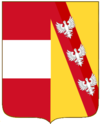 |
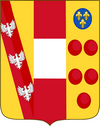 |
 |
|---|---|---|---|
When Maria Theresa married the duke of Lorraine, Francis Stephen (see above), there was a desire to show that the ruling dynasty continued as did all its inherited rights, as the ruling dynasty's right to rule was based on inherited legitimate birthright in each of the constituent territories. Using the concept of "Habsburg" as the traditional Austrian ruler was one of those ways. When Francis I became Emperor of Austria, there was an even further reinforcement of this by the reappearance of the arms of Habsburg in the tripart personal arms of the house with Austria and Lorraine. This also reinforced the "Germaness" of the Austrian Emperor and his claim to rule in Germany against the Prussian Kings, or at least to be included in "Germany". As Emperor Francis Joseph wrote to Napoleon III „Nein, ich bin ein deutscher Fürst“ [31] In the genealogical table above, some younger sons who had no prospects of the throne, were given the personal title of "count of Habsburg".
Today, as the dynasty is no longer on the throne, the surname of members of the house is taken to be "von Habsburg" or more completely "von Habsburg-Lothringen" (see Otto von Habsburg and Karl von Habsburg). Princes and members of the house use the Tripartite arms shown above, generally forgoing any imperial pretentions.
Arms of Dominion of the Austro-Hungarian Empire
[edit]The arms of dominion began to take on a life of their own in the 19th century as the idea of the state as independent from the Habsburg dynasty took root. They are the national arms as borne by a sovereign in his capacity as head of state and represent the state as separate from the person of the monarch or his dynasty. That very idea had been, heretofore, foreign to the concept of the Habsburg state. The state had been the personal property of the Habsburg dynast. Since the states, territories, and nationalities represented were in many cases only united to the Austro-Hungarian Empire by their historic loyalty to the head of the house of Habsburg as hereditary lord, these full ("grand") arms of dominion of Austria-Hungary reflect the complex political infrastructure that was necessarily to accommodate the many different nationalities and groupings within the empire after the Austro-Hungarian Compromise of 1867.


After 1867 the eastern part of the empire, also called Transleithania, was mostly under the domination of the Kingdom of Hungary. The shield integrated the arms of the kingdom of Hungary, with two angels and supporters and the crown of St. Stephen, along with the territories that were subject to it:
The Kingdom of Dalmatia, the Kingdom of Croatia, the Kingdom of Slavonia (conjoined with Croatia as the Kingdom of Croatia-Slavonia - formally known as the Triune Kingdom of Croatia, Slavonia, and Dalmatia, although the claim to Dalmatia was mostly de jure), the Great Principality of Transylvania, the Condominium of Bosnia and Herzegovina (1915–1918), the City of Fiume and its district (modern Rijeka), and in the center, the Kingdom of Hungary.
The western or Austrian part of the empire, Cisleithania, continued using the shield of the Empire in 1815 but with the seals of various member territories located around the central shield. Paradoxically, some of these coats of arms belonged to the territories that were part of the Hungarian part of the empire and shield. This shield, the most frequently used until 1915, was known as the middle shield. There was also the small shield, with just the personal arms of the Habsburgs, as used in 1815.
| I | II | III | IV | V |
|---|---|---|---|---|

|

|

| ||
| Kingdom of Hungary | Kingdom of Galicia and Lodomeria | Archduchy of Austria | Duchy of Salzburg | Duchy of Styria |
| VI | VII | VIII | ||

|

|

|

|

|
| Duchy of Tirol | Duchy of Carinthia and Duchy of Carniola (Marshalled) | Margraviate of Moravia and Duchy of Silesia (Marshalled) | ||
| IX | X | XI | ||

|

| |||
| Great Principality of Transylvania | Kingdom of Illyria | Kingdom of Bohemia | ||
Version of 1915
[edit]In 1915, in the middle of World War I, Austria-Hungary adopted a heraldic composition uniting the shield that was used in the Hungarian part, also known as the Lands of the Crown of St. Stephen, with a new version of the medium shield of the Austrian part as depicted above in the section on the main line of the Emperors of Austria.
Before 1915, the arms of the different territories of the Austrian part of the Empire (heraldry was added to some areas not shown in the previous version and to the left to the Hungarian part) appeared together in the shield positioned on the double-headed eagle coat of arms of the Austrian Empire as an inescutcheon. The eagle was inside a shield with a gold field. The latter shield was supported by two griffins and was topped by the Austrian Imperial Crown (previously these items were included only in the large shield). Then, shown in the center of both arms of dominion, as an inescutcheon to the inescutcheon, is the small shield, i.e. personal arms, of the Habsburgs. All this was surrounded by the collar Order of the Golden Fleece[32][33]

In the heraldic composition of 1915, the shields of the two foci of the empire, Austria and Hungary, were brought together. The griffin supporter on the left was added for Austria and an angel on the right as a supporter for Hungary. The center featured the personal arms of the Habsburgs (Habsburg, Austria and Lorraine). This small shield was topped with a royal crown and surrounded by the collar of the Order of the Golden Fleece, below which was the Military Order of Maria Theresa, below which was the collars of the Orders of St. Stephen's and Leopold. At the bottom was the motto that read "AC INDIVISIBILITER INSEPARABILITER" ("indivisible and inseparable"). There were other simplified versions which did not have the supports depicted, and the simple shields of Austria and Hungary. These were the arms of the Empire of Austria with an inescutcheon of Austria, and the Arms of Hungary (with chequer of Croatia at the tip).

| Shield | Partition | Territory |
|---|---|---|
 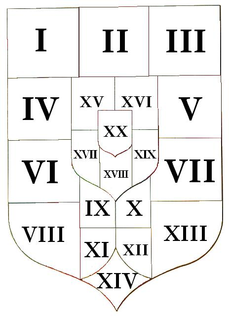 |
II III IV V VI VII VIII IX X XI XII XIII XIV XV XVI XVII XVIII XIX XX |
Kingdom of Galicia and Lodomeria Kingdom of Bohemia Kingdom of Dalmatia Duchy of Upper and Lower Silesia Duchy of Salzburg Margraviate of Moravia County of Tirol Duchy of Bukovina Province of Vorarlberg Margraviate of Istria County of Gorizia (part of the Princely County of Gorizia and Gradisca) County of Gradisca (also part of the Princely County of Gorizia and Gradisca) Province of Bosnia and Herzegovina (Conjoined) Imperial Free City of Trieste Archduchy of Lower Austria Archduchy of Upper Austria Duchy of Styria Duchy of Carniola Duchy of Carinthia Archduchy of Austria |
| Shield | Partition | Territory |
|---|---|---|
 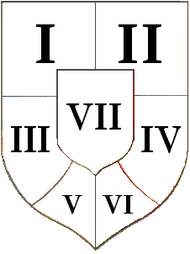 |
II III IV V VI VII |
Kingdom of Dalmatia (Legally Hungarian) Kingdom of Croatia Kingdom of Slavonia Grand Principality of Transylvania Province of Bosnia and Herzegovina (Conjoined) City of Fiume and its district Kingdom of Hungary |
| Shield | Partition | Significance |
|---|---|---|
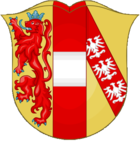 |
II III |
Count of Habsburg Archduke of Austria Duke of Lorraine |
Gallery
[edit]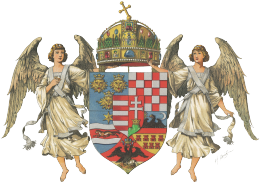
|

|
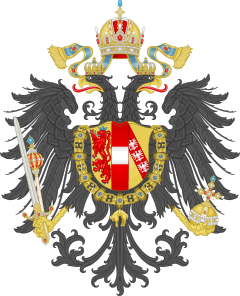
|
| Arms of the Lands of the Crown of Saint Stephen (1867–1915) | Arms of the Lands of the Crown of Saint Stephen (1915–1918) | Small Arms of Austria (Cisleithania)(1805–1918) |
|---|---|---|

|

|

|
| Simple Arms of Cisleithania (1915–1918) | Personal Arms of the Emperor Franz Josef (1848–1916) | Simple Arms of the Austrian and Hungarian parts of the empire. (1915–1918) |
See also
[edit]- A.E.I.O.U.
- Austria-Hungary
- Austrian Empire
- Dukes of Lorraine family tree
- Grand Duchy of Tuscany
- Habsburg family tree
- Habsburg Monarchy
- Habsburg Spain
- Kings of Germany family tree
- List of rulers of Austria
- List of rulers of Lorraine
- Royal intermarriage
- Mandibular prognathism ("Habsburg lip")
- Mayerling Incident
- Ottoman–Habsburg wars
- Thirty Years' War
-
Hofburg Palace, Vienna
-
Schönbrunn Palace, Vienna
Notes
[edit]- ^ "The House of Austria – the Habsburgs and the Empire"
- ^ Paula Sutter Fichtner, "Dynastic Marriage in Sixteenth-Century Habsburg Diplomacy and Statecraft: An Interdisciplinary Approach," American Historical Review Vol. 81, No. 2 (April 1976), pp. 243-265 in JSTOR
- ^ The Kingdom of Germany was within the Holy Roman Empire from 962 until 1806.
- ^ King of the Romans" was, from the time of Emperor Henry II (1014–1024), the title used by the German king following his election by the princes. The title King of the Romans became functionally obsolete after 1508.
- ^ "Habsburger-Gedenkjahr im Aargau", Neue Zürcher Zeitung, (page 17) 23 May 2008.
- ^ art-tv.ch
- ^ "Kanton Aargau" (in German). Archived from the original on December 23, 2008.
- ^ a b c d e f g Heinz-Dieter Heimann: Die Habsburger. Dynastie und Kaiserreiche. ISBN 3-406-44754-6.
- ^ a b Erbe, Michael: Die Habsburger 1493-1918. Eine Dynastie im Reich und in Europa. W. Kohlhammer, 2000. ISBN 3-17-011866-8
- ^ Great Events from History, The Renaissance & Early Modern Era, Vol I, p. 112–114, author-Clare Callaghan, ISBN 1-58765-214-5.
- ^ Alvarez, Gonzalo; Ceballos, Francisco C.; Quinteiro, Celsa (April 15, 2009). Bauchet, Marc (ed.). "The Role of Inbreeding in the Extinction of a European Royal Dynasty". PLOS ONE. 4 (4): e5174. doi:10.1371/journal.pone.0005174. PMC 2664480. PMID 19367331.
- ^ FC Ceballos; G Alvarez (2013). "Royal dynasties as human inbreeding laboratories: the Habsburgs". Heredity. 111 (2): 114–121. doi:10.1038/hdy.2013.25. PMC 3716267. PMID 23572123.
- ^ Maria Theresa was originally engaged to Léopold Clément of Lorraine, older brother of Francis Stephan.
- ^ a b Chisholm, Hugh, ed. (1911). . Encyclopædia Britannica. Vol. 3 (11th ed.). Cambridge University Press. pp. 2–39.
- ^ Microsoft Encarta: The height of the dual monarchy
- ^ Spielvogel, Jackson J. Western Civilization: Comprehensive Volume. 5th ed. Belmont, CA: Thomson/Wadsworth, 2003. 330. Print.
- ^ Heinz-Dieter Heimann (2001). Die Habsburger: Dynastie und Kaiserreiche. C.H.Beck. p. 22. ISBN 978-3-406-44754-9.
- ^ "House of Habsburg". www.coinshome.net. Retrieved 2019-04-21.
- ^ "The World of Habsburgs". 2011. Retrieved 2019-04-21.
- ^ Heinz-Dieter Heimann (2001). Die Habsburger: Dynastie und Kaiserreiche. C.H.Beck. p. 22. ISBN 978-3-406-44754-9.
- ^ Andreas Bönner (2010). Die Religionspolitik der Habsburger Kaiser in der Zeit des Dreißigjährigen Krieges. GRIN Verlag. p. 7. ISBN 978-3-640-50510-4.
- ^ Image:Habsburg Family Tree.jpg
- ^ a b Montgomery-Massingberd, Hugh. "Burke’s Royal Families of the World: Volume I Europe & Latin America, 1977, pp. 18, 32. ISBN 0-85011-023-8
- ^ Heinz-Dieter Heimann (2001). Die Habsburger: Dynastie und Kaiserreiche. C.H.Beck. p. 22. ISBN 978-3-406-44754-9.
- ^ Andreas Bönner (2010). Die Religionspolitik der Habsburger Kaiser in der Zeit des Dreißigjährigen Krieges. GRIN Verlag. p. 7. ISBN 978-3-640-50510-4.
- ^ "The World of Habsburgs". 2011. Retrieved 2019-04-21.
- ^ Genealogisches Hanbduch des Adels, Furstliche Hauser Band XIV. Limburg ad der Lahn, Germany: C. A. Starke Verlag. 1991. pp. 91–93. ISBN 3-7980-0700-4.
- ^ Heinz-Dieter Heimann: Die Habsburger. Dynastie und Kaiserreiche. ISBN 3-406-44754-6. pp. 38–45.
- ^ a b c d e f List of nicknames of European royalty and nobility: C
- ^ "Otto von Habsburg, heir to Austria's last emperor, dies at 98". The Local: Germany's News in English. Retrieved 18 December 2012.
- ^ 1: Wolfgang Menzel: Die letzten 120 Jahre der Weltgeschichte, Band 6 (1740-1860), Adolph Krabbe, Stuttgart 1860, S. 211 Online, p. 211, at Google Books
2.: Wolfgang Menzel: Supplementband zu der Geschichte der letzten 40 Jahre (1816-1856). Adolph Krabbe, Stuttgart 1860, S. 153 Online, p. 153, at Google Books
Aus diesem wurde später: „Sire, ich bin ein deutscher Fürst“:
Hermann Struschka: Kaiser Franz Josef I. Georg Szelinski, Wien 1888, S. 22 Online, p. 22, at Google Books
Es kommt auch in der anglifizierten Schreibung „Sir, ich bin deutscher Fürst“ vor.
Stenographische Protokolle – Abgeordnetenhaus – Sitzungsprotokolle. Haus der Abgeordneten – 14. Sitzung der XVIII. Session am 16. Juli 1907, S. 1337 alex.onb.ac.at 3: wikiquote:de:Franz Joseph I. von Österreich - ^ H. Ströhl: Die neuen österreichischen, ungarischen und gemeinsamen Wappen. Hrsg. auf Grund der mit d. allerhöchsten Handschreiben vom 10. u. 11. Okt. 1915, bezw. 2. u. 5. März 1916 erfolgten Einführung. Viena 1917.
- ^ "Diem, P. Die Entwicklung des österreichischen Doppeladlers". Retrieved 5 July 2012.
Further reading
[edit]- Agamov A.M. Dynasties of Europe 400--2016: Complete Genealogy of Sovereign Houses (In Russian). URSS, Moscow, 2017. P. 27-33
- Brewer-Ward, Daniel A. The House of Habsburg: A Genealogy of the Descendants of Empress Maria Theresia. Clearfield, 1996.
- Crankshaw, Edward. The Fall of the House of Habsburg. Sphere Books Limited, London, 1970. (first published by Longmans in 1963)
- Evans, Robert J. W. The Making of the Habsburg Monarchy, 1550–1700: An Interpretation. Clarendon Press, 1979.
- McGuigan, Dorothy Gies. The Habsburgs. Doubleday, 1966.
- Palmer, Alan. Napoleón and Marie Louise Ariel Mexico, 2003.
- Wandruszka, Adam. The House of Habsburg: Six Hundred Years of a European Dynasty. Doubleday, 1964 (Greenwood Press, 1975).
External links
[edit]- http://habsburg.yolasite.com/ The Habsburg Family Association
- "Erzherzog Dr. Otto von Habsburg" (Autorisierte Ehrenseite) in German
- Habsburg Biographies
- Habsburg History
- Habsburg Resource Centre on SurnameWeb
- http://www.ac.wwu.edu/~stephan/Rulers/hapsburg3.html
- Genealogical tree of the house of Habsburg (up until Maria Theresia)
- Marek, Miroslav. "Genealogy of the Habsburgs from Genealogy.eu". Genealogy.EU.
{{cite web}}: External link in|publisher= - "Inbreeding caused demise of the Spanish Habsburg dynasty, new study reveals" (15 April 2009)
- Family tree of the Kings of the House of Habsburg
















































